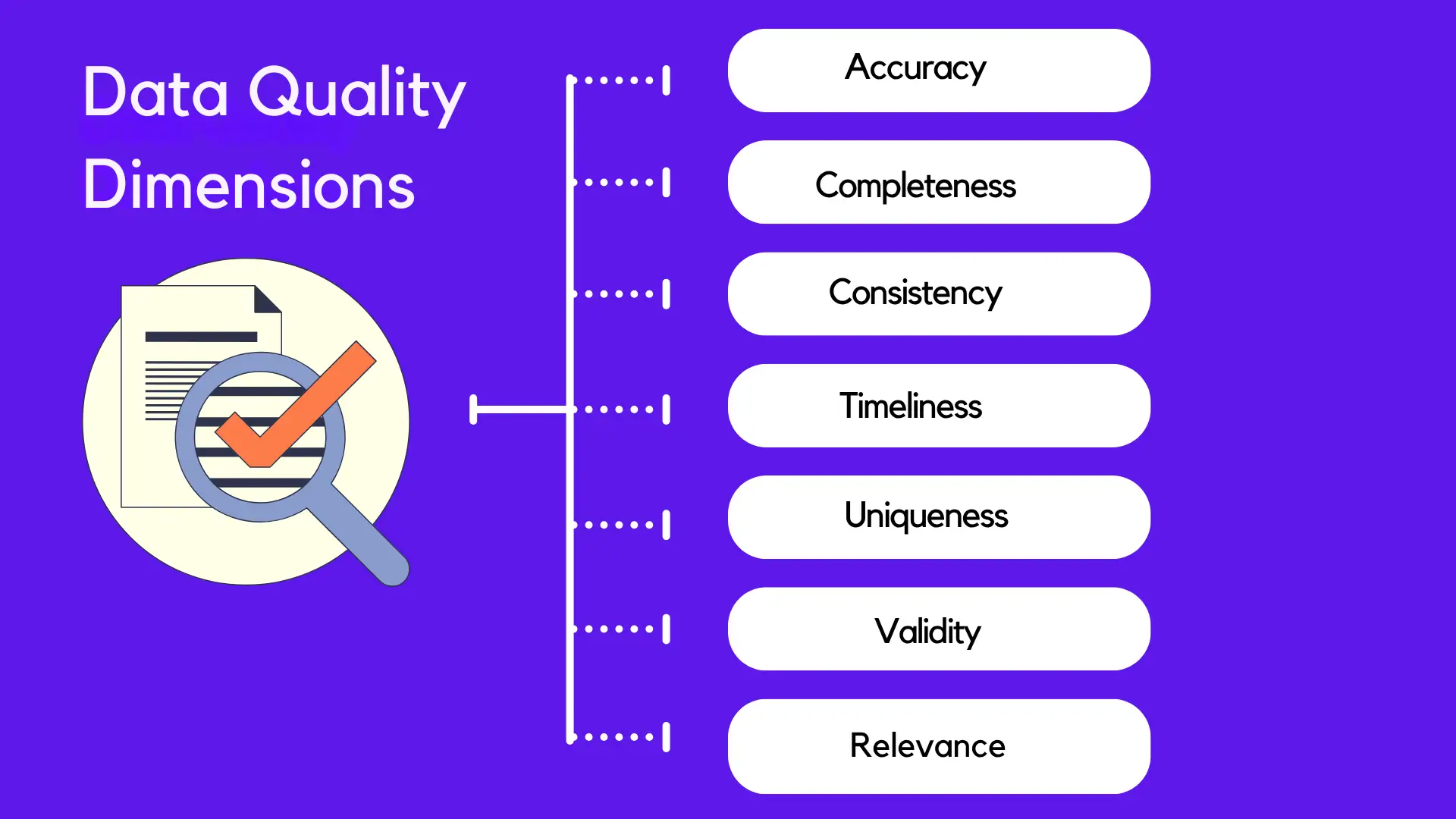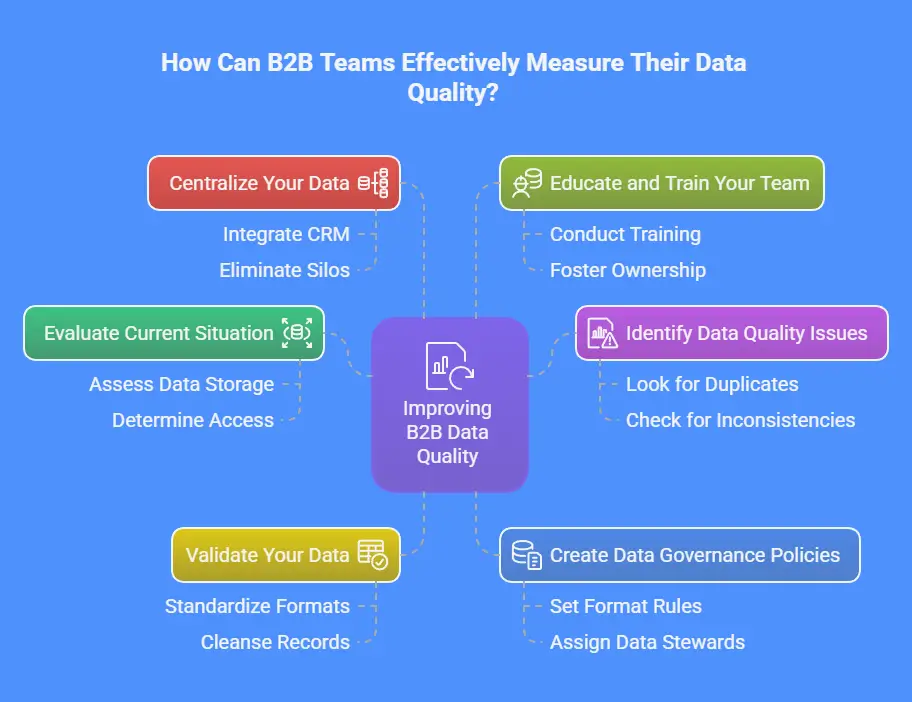
B2B teams running sales and marketing campaigns often focus on reaching more contacts, assuming that volume equals results. However, without clean and reliable data, outreach efforts fail.
Poor data quality is costly. According to IBM reports, bad data costs U.S. businesses over $3 trillion annually. This translates to wasted spend, missed targets, and broken customer experiences in sales and marketing.
The good news is that you can improve it. Whether using a CRM, email list, or marketing automation tool, enhancing data quality leads to more meaningful conversations and higher conversions.
Table of Contents:
- What is Data Quality?
- Why Data Quality is Important in Sales & Marketing?
- What Are the Dimensions of Data Quality in Marketing Databases?
- How Can B2B Teams Effectively Measure Their Data Quality?
- Examples of Data Quality Metrics for Sales & Marketing
- Best 6 Tools to Improve Data Quality
- Conclusion
- Data Quality Frequently Ask Questions (FAQs)
What is Data Quality?
Data quality refers to how well your data fits its intended purpose. In b2b marketing and sales, that typically means using data to segment audiences, personalize outreach, prioritize leads, and make strategic decisions. Your results will suffer if your data isn’t accurate, complete, consistent, or timely.
Data quality is a collection of attributes and procedures that ensure data reliability. These attributes form the foundation for measuring, managing, and improving data over time.
Ensure Your B2B Data Works as Hard as You Do
Supercharge your sales and marketing with PrimeRole’s enriched, verified contact data that fuels smarter decisions.
Why Data Quality is Important in Sales & Marketing?
Investing in data quality pays off quickly, especially for B2B teams relying on high-volume, high-stakes campaigns. Here’s how improving your quality of data can increase performance across the board:
1. Unlock More Sales Opportunities
Accurate, up-to-date data fuels smarter targeting. When you know who your buyers are and what they care about, you can reach them faster with resonated messaging. That means more qualified leads, more productive calls, and more closed-won deals. High-quality data doesn’t just support revenue growth; it accelerates it.
2. Improve Outreach Personalization
Personalized emails and calls outperform generic outreach by a wide margin. However, personalization only works when the data behind it is accurate. Having correct job titles, company names, and buyer intent signals allows marketing and sales to tailor their messaging and hit the right notes with every touchpoint.
3. Lower Your Email Bounce Rate
High bounce rates don’t just waste effort, they hurt your sender reputation and email deliverability. If your emails aren’t landing in inboxes, your pipeline suffers. Clean, validated contact data helps ensure your emails reach real people, not dead addresses or spam traps.
4. Make Your Metrics Matter
Good data equals good decisions. When your dashboards and CRM fields are filled with trustworthy information, forecasting becomes easier, attribution gets clearer, and results are more actionable. Better reporting starts with better data. And better data starts with a commitment to quality.
5. Align Sales and Marketing
Misaligned teams are a common B2B issue, and poor data is often the culprit. When sales and marketing rely on different, inconsistent data sets, collaboration breaks down. High-quality, centralized data helps ensure both teams are on the same page, targeting the same accounts, measuring the same KPIs, and following a shared strategy.
6. Enhance Lead Scoring Accuracy
Lead scoring models are only as good as the data that feeds them. If your firmographics, engagement signals, or fit data are outdated or incorrect, you’ll end up prioritizing the wrong leads. Quality data ensures your scoring model identifies true high-intent leads, helping you focus on those most likely to convert.
What Are the Dimensions of Data Quality in Marketing Databases?
Data quality is the foundation of high-performing strategies and pipeline growth. But it isn’t a one-dimensional metric. It spans several critical dimensions that collectively determine how reliable, useful, and actionable your database is.
Let’s explore the seven essential dimensions of data quality in marketing databases.

1. Accuracy
Accurate data is the bedrock of effective outreach. Inaccuracies like wrong job titles or outdated company names can lead your team to engage the wrong person entirely. For B2B sales and marketing, accuracy ensures reps spend time on valid prospects, not dead ends. Imagine sending a demo invite to someone who left the company last year. It’s a waste of effort, and worse, it reflects poorly on your brand.
2. Completeness
Every missing field is a missing opportunity. An email without a phone number or a lead without industry info makes personalization harder and targeting weaker. Complete data means having all the essential details like company size, role, location, and buying signals that empower your team to execute segmented campaigns confidently.
3. Consistency
When data varies between platforms like "CMO" in one system and "Chief Marketing Officer" in another it creates disconnects. Consistent data ensures your CRM, email tool, and reporting dashboards speak the same language. This alignment fuels smooth automation, better insights, and seamless buyer journeys.
4. Timeliness
People switch roles, companies rebrand, and org charts change. If your data isn’t current, your outreach won’t land. Timely data keeps your campaigns relevant and your pipeline accurate. It means fewer bounce backs and more real time decisions.
5. Uniqueness
No one wants two reps chasing the same lead. Duplicate records bloat your CRM and muddy your reporting. Ensuring uniqueness eliminates redundancies, maintains clean pipelines, and boosts internal coordination.
6. Validity
Valid data adheres to expected formats and rules. Whether it's a proper email address, postal code, or job title, validity ensures the data you collect can be used reliably. Invalid inputs break automation flows and hurt deliverability.
7. Relevance
Even flawless data is useless if it doesn't serve your goal. Relevance means focusing on data that fits your ICP. A lead outside your target industry or geography might be perfect for someone, but not for you. Filtering out the noise allows your team to zero in on high-potential accounts.
How Can B2B Teams Effectively Measure Their Data Quality?
To know whether your data is helping or hurting your efforts, you need to measure it. Here’s how:

1. Evaluate Your Current Situation
Before improving data quality, B2B teams need to understand their existing data environment. This involves assessing where data resides, how it’s gathered, who manages it, and whether it’s maintained regularly. A clear view of your current data landscape helps identify inefficiencies, redundancies, and gaps that must be addressed before any optimization can begin.
- Identify where your data is stored and how it’s collected
- Determine who has access and if it’s updated regularly
- Clarify ownership and accountability for data upkeep
2. Identify Data Quality Issues
Recognizing data quality issues is critical to preventing wasted effort and budget. Once your current state is clear, dig into common problems like duplicate records, outdated fields, and inconsistent formatting. Understanding the root causes such as poor data entry or unreliable vendors helps B2B teams prioritize fixes that improve performance and support compliant, relevant outreach.
- Look for outdated contact details, missing fields, or duplicates
- Check for inconsistent formats and non-ICP leads
- Investigate root causes like poor entry protocols or unverified sources
3. Validate Your Data
Validation ensures your data is correct, relevant, and usable. This step involves standardizing formats, cleaning duplicate or decayed records, and verifying key details with trusted sources. Without validation, your teams risk acting on flawed insights. Leveraging sales intelligence tools like PrimeRole can significantly improve the accuracy and longevity of your data assets.
- Standardize formats (e.g., dates, job titles)
- Remove duplicates and cleanse irrelevant entries
- Use third-party tools or providers like PrimeRole for verified and enriched data.
4. Create Data Governance Policies
Strong data governance defines how data is handled across your organization. It ensures consistency, assigns responsibility, and promotes accountability. Governance frameworks help prevent confusion by setting clear rules for formatting, required fields, and access control. When teams follow the same playbook, the result is cleaner, more reliable, and compliant data over time.
- Set standards for required fields and format rules
- Assign data stewards for accountability
- Train teams on protocols and enforce regular audits
5. Centralize Your Data
When data is siloed across departments and tools, misalignment and redundancy are inevitable. Centralizing your data into a unified CRM or integrated system eliminates fragmentation, ensures consistency, and improves collaboration between sales, marketing, and operations. It also gives everyone access to the same, up-to-date data for better decision-making and campaign execution.
- Integrate sales, marketing, and ops into one CRM or data platform
- Eliminate data silos to ensure accuracy and consistency
- Enable real-time access to a single source of truth
6. Educate and Train Your Team
Even the best data systems can be undermined by human error. That’s why training your team is just as important as technology. Regularly educating your staff on SOPs, the impact of bad data, and the importance of data hygiene fosters a culture of responsibility. This helps ensure every employee contributes to cleaner, higher-quality data.
- Conduct regular training sessions on SOPs and data hygiene
- Show how poor data impacts performance and revenue
- Foster a culture where everyone takes ownership of data integrity
Take Control of Your Data Health
From validation to governance, use PrimeRole to measure, clean, and upgrade your marketing database with ease.
Examples of Data Quality Metrics for Sales & Marketing
Measuring data quality requires tracking the right metrics. Here are some essential ones for B2B sales and marketing teams:
1. Completeness Score
The percentage of records that have all essential fields filled (like name, email, company, phone number, job title). High completeness ensures your marketing campaigns can be personalized and your sales team has enough context to qualify leads. Incomplete records limit segmentation and decision-making.
Formula: (Complete Records ÷ Total Records) × 100
2. Bounce Rate
The percentage of emails that fail to reach recipients, either due to invalid addresses or delivery issues. A high bounce rate is a clear indicator of poor email hygiene and outdated data. Keeping this low is critical to maintaining sender reputation and inbox placement.
Formula: (Bounced Emails ÷ Emails Sent) × 100
3. Duplicate Rate
The share of records in your database that are repeated or redundant. Duplicates lead to wasted outreach, confusion among teams, and skewed reporting. A low duplicate rate reflects disciplined data entry, deduplication processes, and centralized data handling.
Formula: (Duplicate Records ÷ Total Records) × 100
4. Conversion Rate
The percentage of leads that successfully convert into paying customers. While this is a performance metric, it's heavily influenced by data quality—accurate targeting, clean contact info, and reliable segmentation all raise this number.
Formula: (Customers ÷ Leads) × 100
5. Time-to-Update
The average time it takes for outdated or incorrect data to be identified and corrected. The longer this gap, the more likely your outreach is based on stale information. A shorter time-to-update reflects a more responsive, agile data governance process.
Formula: (Date of Last Update – Date When Data Became Outdated)
Make the Switch to Cleaner, Smarter Data
Join B2B teams using PrimeRole to build high-converting pipelines with enriched, multi-source data.
Best 6 Tools to Improve Data Quality
Managing data quality manually is tedious and error-prone. Here are some tools can automate much of the heavy lifting:
1. PrimeRole
PrimeRole offers waterfall enrichment and a multi-provider verification engine that ensures high-quality, de-duplicated, and accurate B2B data for go-to-market teams. It helps eliminate bad data, scale outreach, and improve campaign ROI. With features like multi-source validation and segment-based enrichment, it’s designed to support sales and marketing at every stage of the funnel.
2. ZoomInfo
ZoomInfo collects, verifies, and updates millions of company and contact profiles in real time. It’s ideal for sales prospecting tools for enrichment, intent signals, and territory management. Many B2B teams rely on it for its detailed filters and integrations with CRMs like Salesforce.
3. Cognism
Cognism provides GDPR and CCPA-compliant B2B data, with direct dials, emails, and verified mobile numbers. The AI Search tool allows users to input queries in plain language, like “Marketing managers in Berlin,” and get relevant contacts. Cognism also includes Bombora intent data, CRM enrichment tools, and Diamond Data® for high-reach phone contacts.
4. Clearbit
Clearbit offers firmographic enrichment APIs and tools for lead scoring and personalization. It’s great for SaaS companies wanting to qualify leads quickly and feed enriched data into marketing automation tools. Its strength lies in real-time data delivery and strong developer-friendly infrastructure.
5. Demandbase
Demandbase is purpose-built for account-based marketing (ABM). It helps teams unify company-level data, track buyer intent, and enrich accounts with technographics and firmographics. Its ABX Cloud integrates well with CRM and marketing automation platforms.
6. Lusha
Lusha provides sales and marketing teams with access to verified B2B contact data directly from LinkedIn, Salesforce, or company websites via its Chrome extension. Known for its simplicity and ease of use, it helps teams quickly find emails and direct dials aligned with GDPR and CCPA standards. Lusha’s integrations with CRMs and automation platforms make pushing enriched data into sales workflows easy, although it operates on a credit-based system for data access.
Conclusion
Data fuels B2B sales and marketing, but not all data holds the same value. When your data is accurate, complete, and up-to-date, your teams perform better. Your outreach resonates, and your reports reflect reality.
Investing in data quality has become a competitive advantage.
Tools like PrimeRole help your team build cleaner pipelines by enriching leads, eliminating duplicates, and enabling sharper targeting across campaigns.
Data Enrichment Frequently Ask Questions (FAQs)
What is the meaning of data quality?
Data quality refers to how accurate, complete, consistent, and reliable your data is. High-quality data reflects real-world entities correctly and supports confident decision-making and strategy.
How to measure data quality?
You can measure data quality using metrics like accuracy, completeness, consistency, timeliness, and validity. These metrics help assess how well your data supports your business goals.
What is a data quality framework?
A data quality framework provides a structured method to monitor, manage, and improve data quality. It includes rules, roles, tools, and processes to keep your data clean and useful.
How to assess data quality?
Assess data quality by reviewing sample data, identifying gaps or errors, validating fields, and using automated tools to detect inconsistencies or outdated information.
